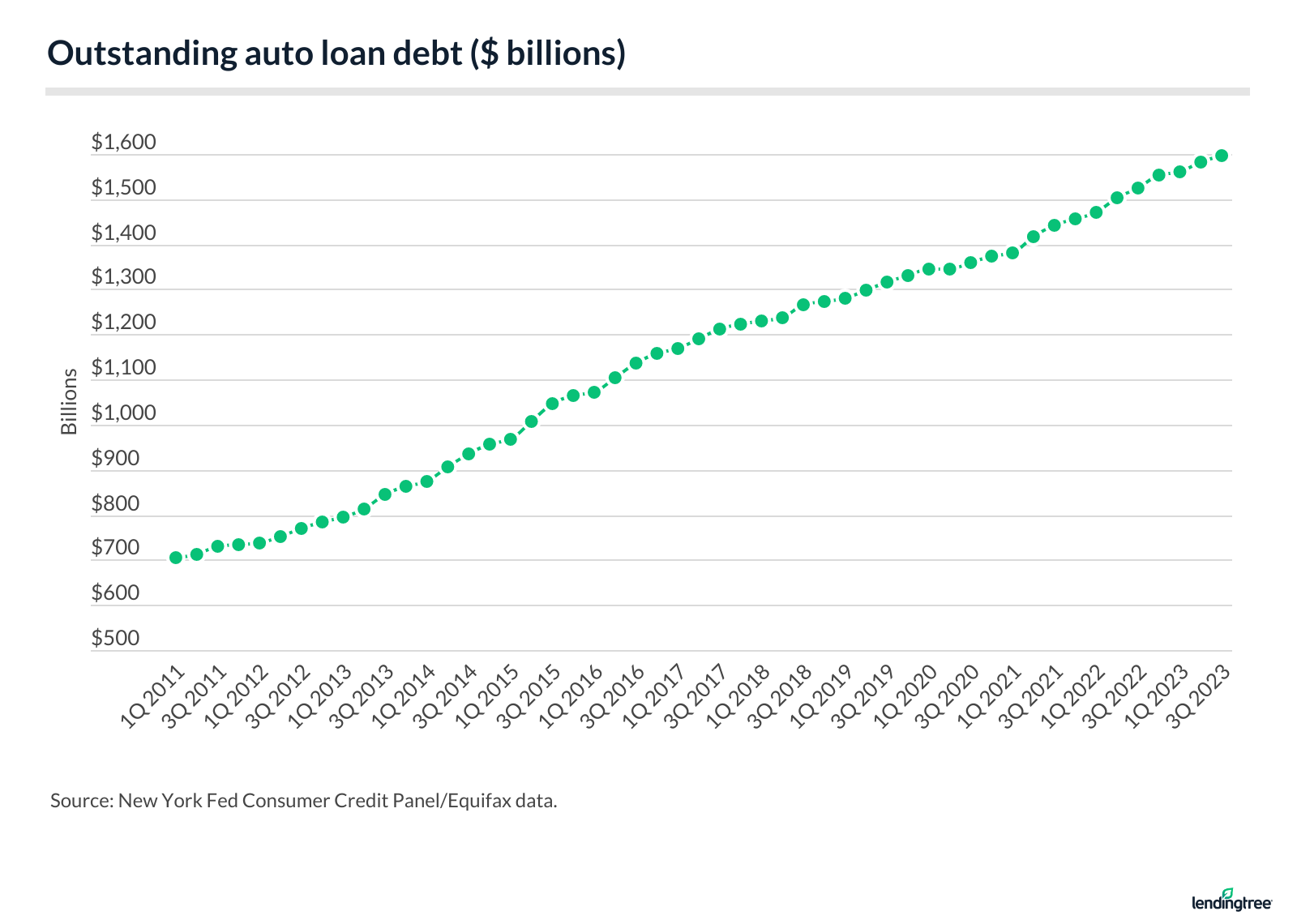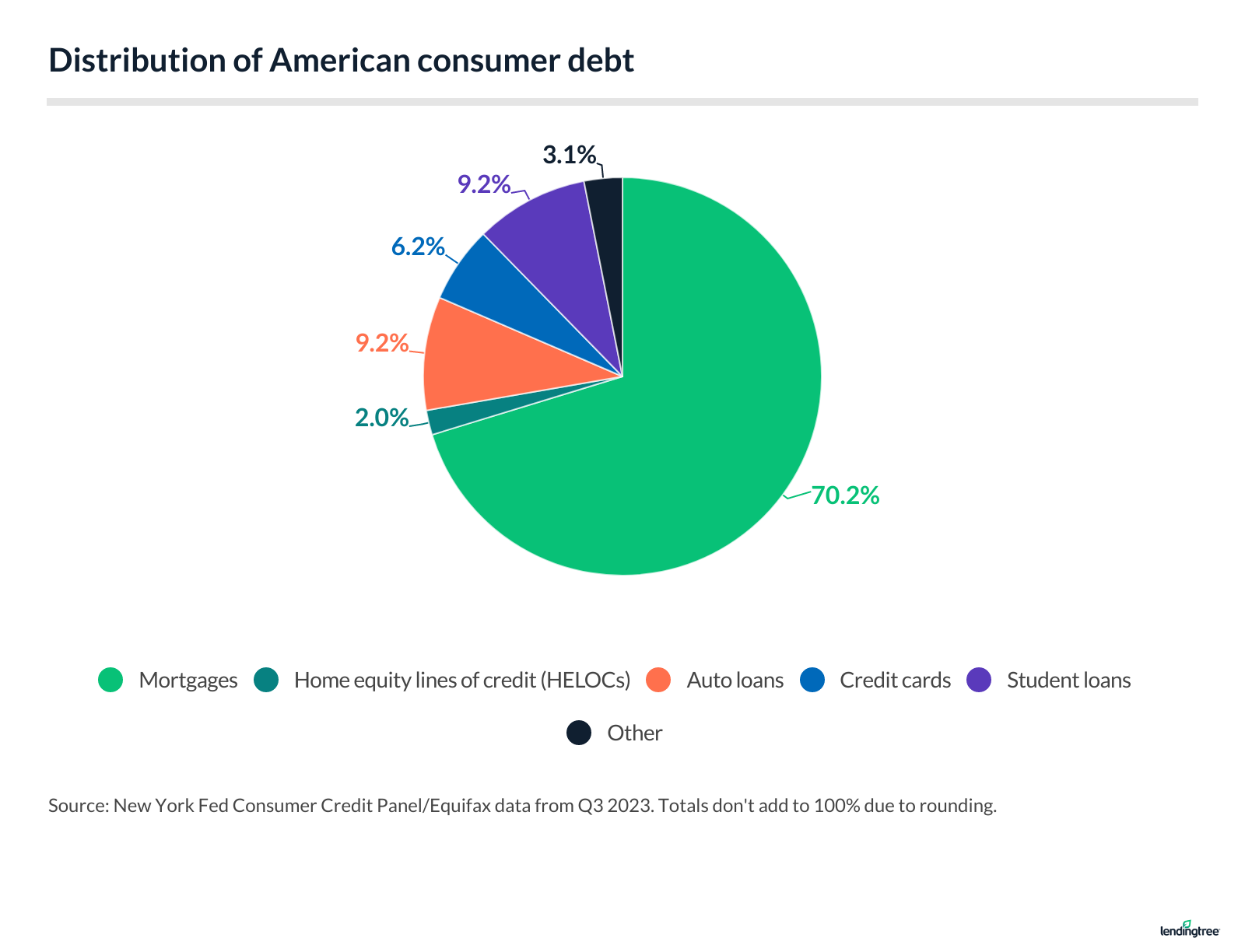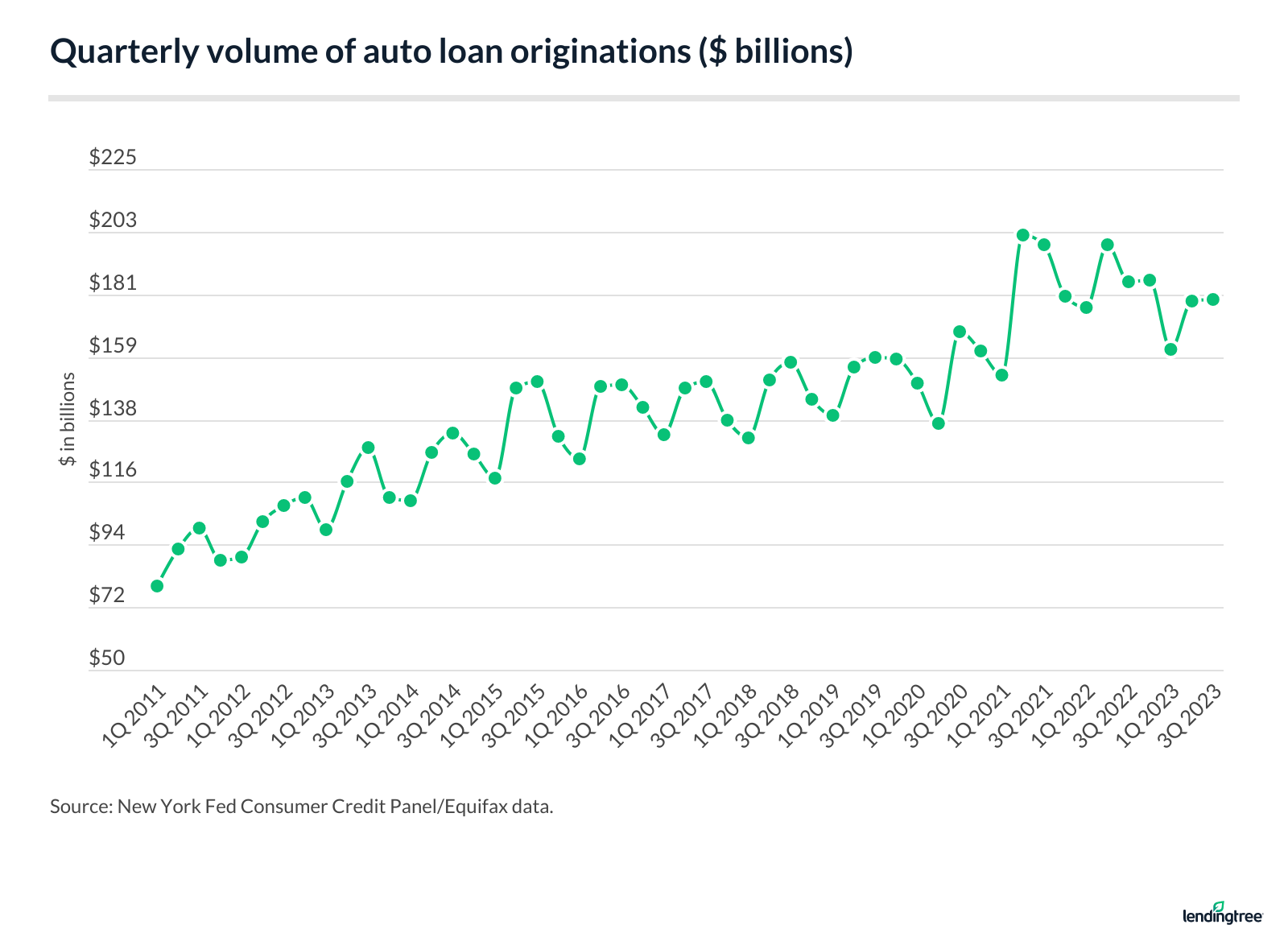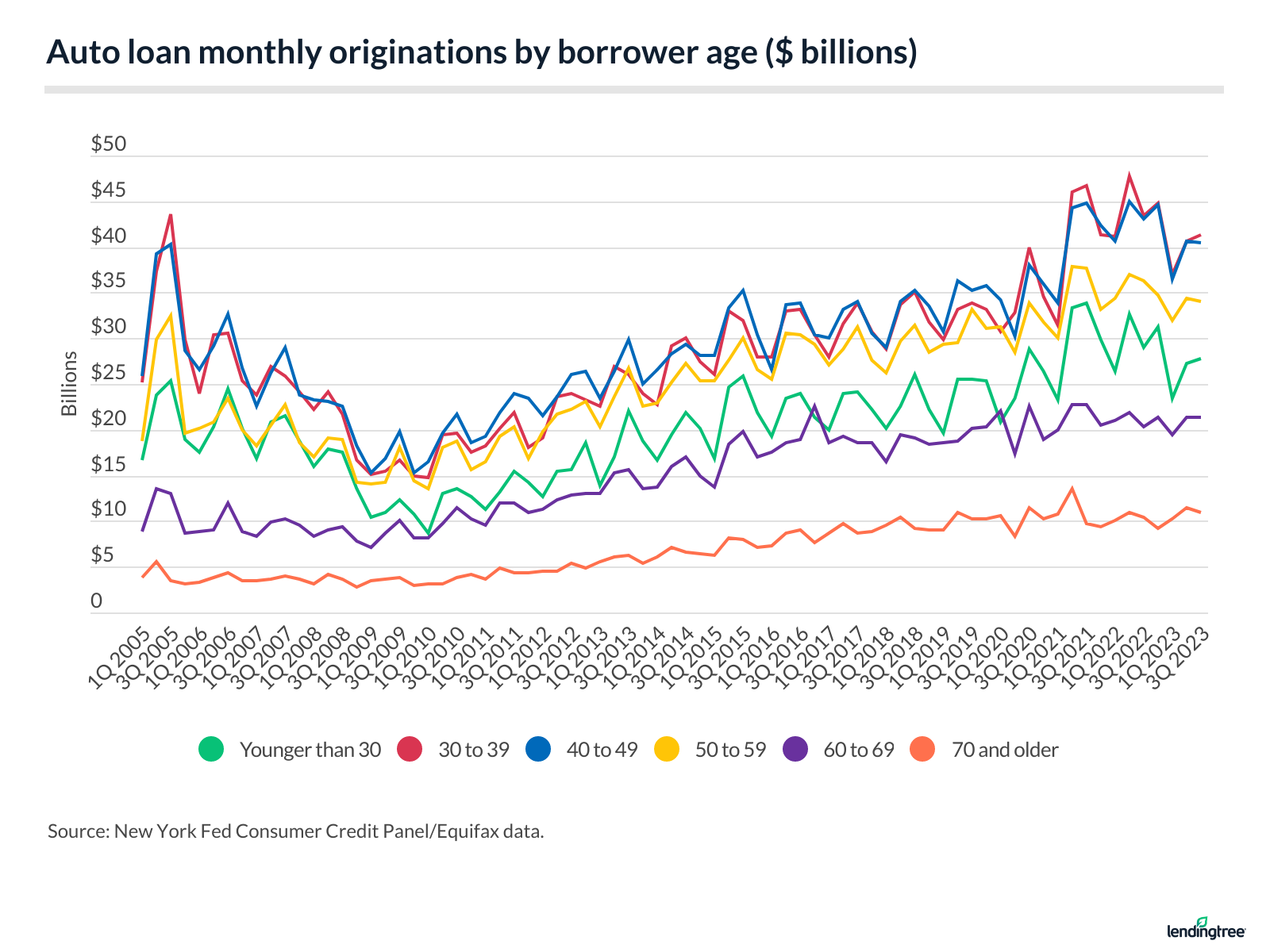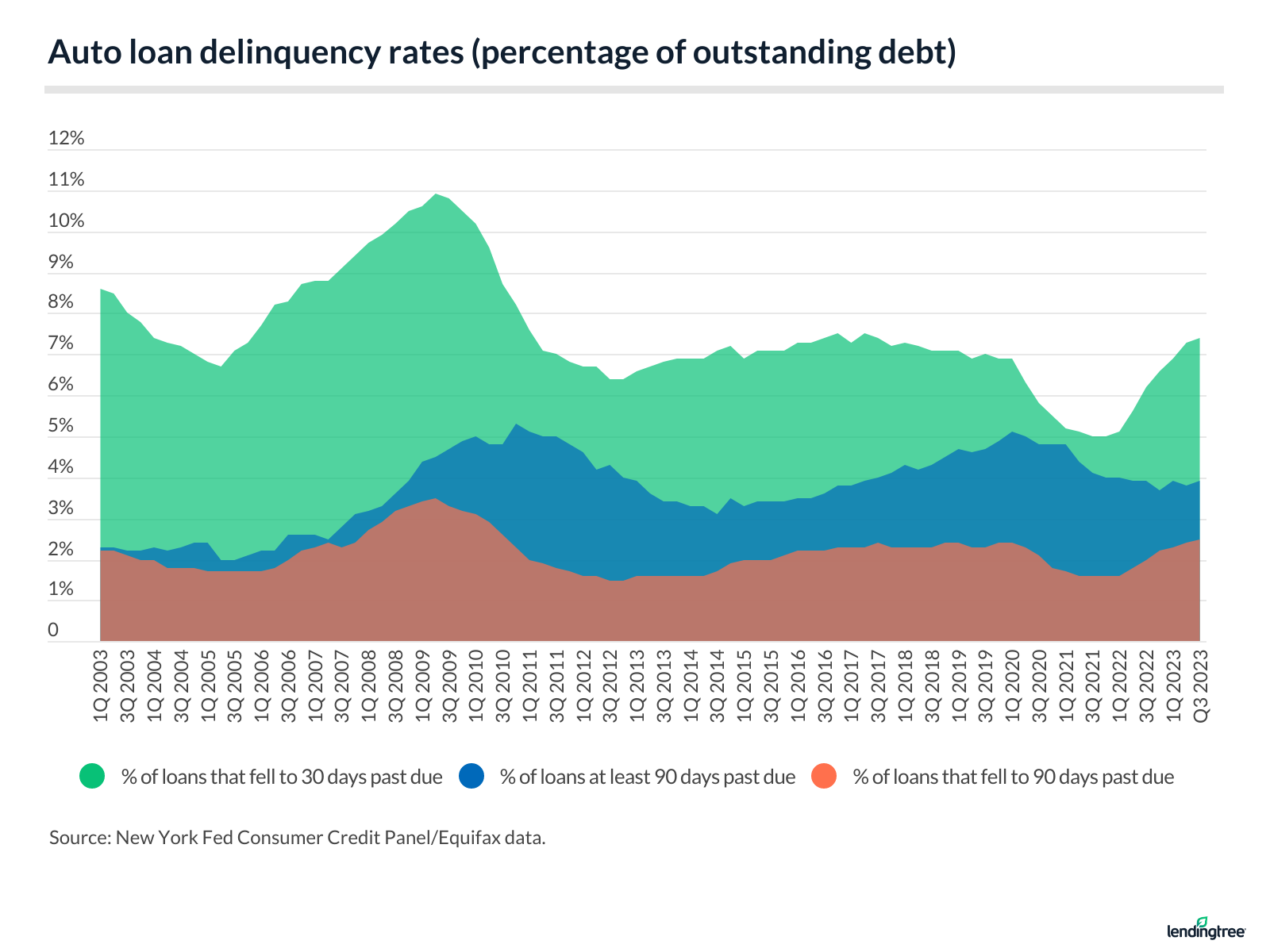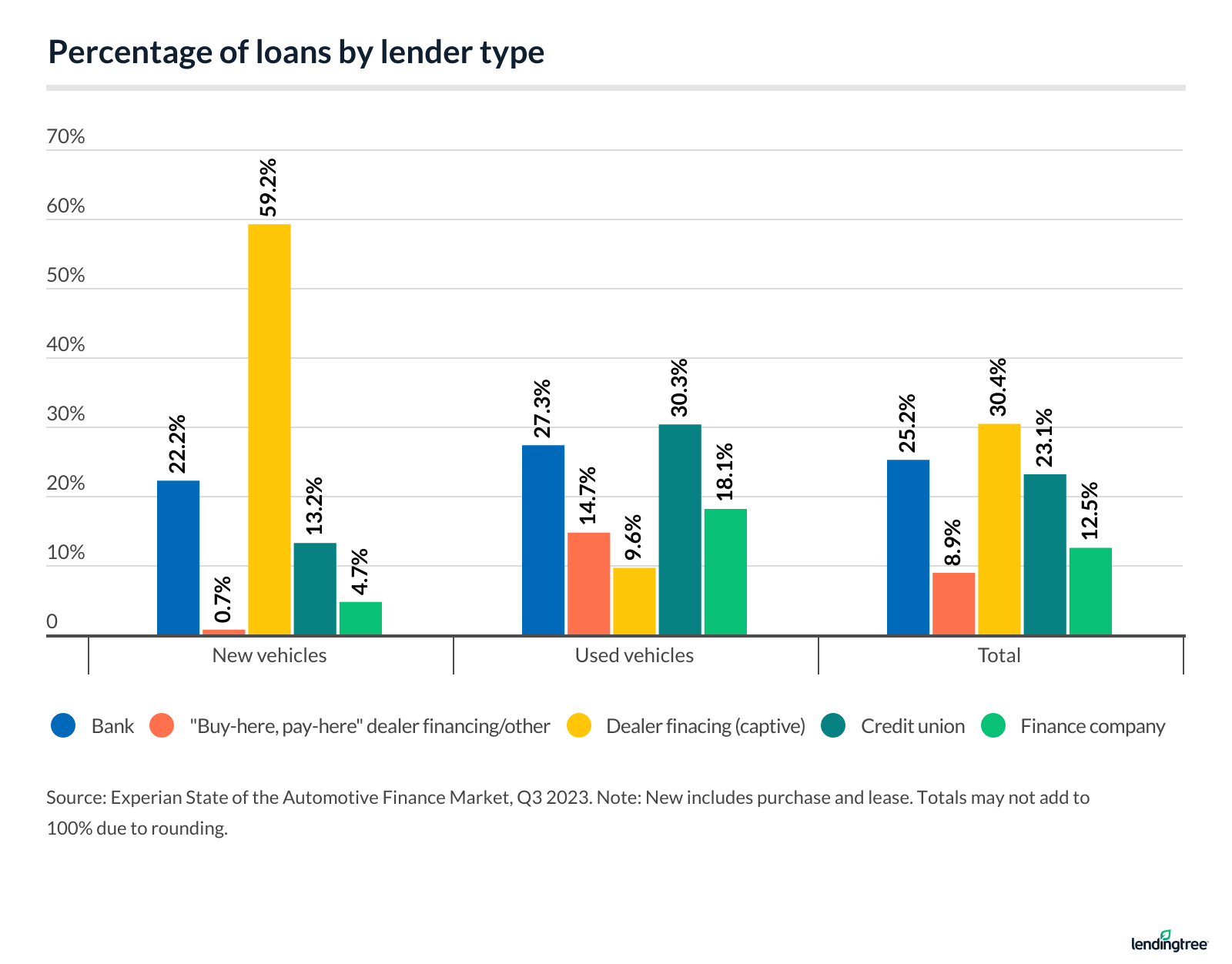Average Car Payment and Auto Loan Statistics 2024
The average car payment for new vehicles was $726 in the third quarter of 2023, a 3.6% increase from the third quarter of 2022. The average car payment for leased vehicles increased at a comparable 4.6%. However, the average car payment for used vehicles increased by just 0.8%.
LendingTree looked at payments, originations, term lengths, delinquencies and more to get a full picture of U.S. auto loan debt and trends. Here’s our 2024 roundup of auto loan statistics.
Auto loan statistics 2024: Average car payments to financing by credit score
- Average car payments for new, leased and used vehicles in the U.S. increased year over year. The jumps were 3.6% for new vehicles and 4.6% for new leased vehicles, according to third-quarter 2023 data from Experian. The increase in the average car payment for used vehicles was significantly smaller, at 0.8%. That puts average monthly car payments at $726, $597 and $533, respectively.
- Increases in new vehicle prices aren’t as severe. New vehicle prices are up 1.9% year over year, according to the October 2023 U.S. Bureau of Labor Statistics (BLS) consumer price index, but used car and truck prices are down 7.1%. Americans borrow an average of $40,184 for new vehicles and $27,167 for used vehicles, according to Experian.
- Auto loan debt is the third-largest category behind mortgages and nearly equal to student loans. Overall, Americans owe $1.595 trillion in auto loan debt, according to the Federal Reserve Bank of New York, accounting for 9.2% of American consumer debt.
- On average, Americans took out $59.8 billion in new auto loans each month in the third quarter of 2023. By age, Americans younger than 50 took out $36.6 billion in auto debt monthly during the third quarter, according to the New York Fed, compared with $22.1 billion among those 50 and older.
- Americans are taking many years to pay back their auto loans. The average auto loan term is 68.3 months for new cars, 67.6 months for used cars and 36.2 months for leased vehicles, according to Experian.
- Auto loan delinquency rates are up compared to last year. 3.9% of outstanding auto debt was at least 90 days late in the third quarter of 2023, according to the New York Fed, up 0.5% from the third quarter of 2022. Meanwhile, the percentage of auto loans that fell to 30 days due was 7.4% in the third quarter this year, up 19.0% from 6.2% in the third quarter last year.
- Borrowers with prime credit scores are responsible for the majority of retail vehicle financing. Borrowers with credit scores of 661 and higher account for 68.7% of retail vehicle financing, according to Experian, versus 14.2% for subprime borrowers with credit scores of 600 or lower.
Average monthly car payments for new, new leased and used vehicles jump year over year
The average car payment for a new vehicle is $726 monthly, according to third-quarter 2023 data from Experian — up 3.6% year over year. Meanwhile, new lease payments average $597 (up 4.6%). With the lowest jump at 0.8%, used cars have the lowest average monthly payment at $533.
Annual changes in average monthly car payments
| 2022 payments | 2023 payments | Difference ($) | Difference (%) | |
|---|---|---|---|---|
| New vehicles | $701 | $726 | $25 | 3.6% |
| Used vehicles | $529 | $533 | $4 | 0.8% |
| New vehicle leases | $571 | $597 | $26 | 4.6% |
Source: Experian State of the Automotive Finance Market, Q3 2022 and Q3 2023
Those with credit scores of 501 to 600 (in the subprime or poor and fair ranges) and 601 to 660 (in the nonprime or fair ranges) saw the highest average monthly payment for new vehicles, at $769.
Average monthly payments by credit score range
| New vehicles | Used vehicles | New leased vehicles | |
|---|---|---|---|
| All | $726 | $533 | $597 |
| 781 to 850 (super prime) | $693 | $511 | $579 |
| 661 to 780 (prime) | $733 | $527 | $600 |
| 601 to 660 (nonprime) | $769 | $551 | $623 |
| 501 to 600 (subprime) | $769 | $552 | $638 |
| 300 to 500 (deep subprime) | $737 | $535 | N/A |
Source: Experian State of the Automotive Finance Market, Q3 2023
Tip
Increase in new car payments higher than hike in new vehicle prices
The year-over-year hike of 3.6% in the average new car payment is less than 2 percentage points higher than the new vehicle price increase of 1.9% over the past year, according to the October 2023 BLS consumer price index.
While the supply chain has largely recovered from the factory shutdowns and supply chain shortages caused by the COVID-19 pandemic and geopolitical tensions, auto manufacturing still isn’t at pre-pandemic levels. Meanwhile, many consumers have been waiting for increased availability since the shortages began, meaning demand is up — keeping inventory low and prices high. Plus, inflation skyrocketed to a 40-year high, causing more pain for consumers.
The used car market is friendlier to consumers, as used car and truck prices are down by 7.1%. During the pandemic, many shoppers turned to the used car market amid the shortages and price hikes in the new car market. Now, as new car inventory picks up, demand has shifted from the used car market.
Average auto loan amounts above $40,000 for new vehicles
Average auto loan amounts reached $40,184 for new vehicles and $27,167 for used vehicles in the third quarter of 2023, according to Experian. New vehicle loan amounts — while still elevated — have dipped four quarters in a row. Meanwhile, the average auto loan amount for used vehicles is up from $26,863 in the second quarter.
New car buyers in the nonprime/fair credit tier (601 to 660) take out the largest loans — $43,360, on average. Borrowers with credit scores in the tier above — prime (661 to 780) — take out the most for used cars, $28,504, higher than last quarter ($28,402).
Average auto loan amounts by credit score range
| New vehicles | Used vehicles | |
|---|---|---|
| All | $40,184 | $27,167 |
| 781 to 850 | $36,450 | $27,442 |
| 661 to 780 | $41,890 | $28,504 |
| 601 to 660 | $43,360 | $26,981 |
| 501 to 600 | $40,660 | $23,510 |
| 300 to 500 | $36,272 | $20,494 |
Source: Experian State of the Automotive Finance Market, Q3 2023

Americans owe $1.595 trillion in auto loan debt
Overall vehicle debt has increased by 88.8% between the third quarter of 2013 ($845 billion) and the third quarter of 2023 ($1.595 trillion), according to the Federal Reserve Bank of New York.
In those 10 years, the only dip came in the second quarter of 2020 — the first full quarter amid the pandemic.
Auto loans account for 9.2% of American consumer debt
While mortgages take the lion’s share of American consumer debt at 70.2% — according to the New York Fed — auto loans account for 9.2%. That’s tied with student loan debt, though the amount of student loan debt ($1.599 trillion) slightly edges out the amount of auto loan debt ($1.595 trillion).
Americans borrow almost $60 billion a month in auto loans
Americans took out $42.5 billion a month in auto loans in the third quarter of 2013. Ten years later in the third quarter of 2023, they borrowed far more: $59.8 billion a month, according to the New York Fed.
Here’s a quarterly look dating to 2011:
Americans in their 30s, 40s take out biggest auto loans
Americans in their 30s and 40s took out the largest auto loans in the third quarter of 2023, according to the New York Fed, borrowing $41.4 billion and $40.5 billion, respectively.
Those in their 50s borrowed about $6 billion less ($34.1 billion), followed by young adults ages 18 to 29, who borrowed $27.8 billion. The oldest generations borrowed the least.
When you break it down monthly over that third quarter of 2023, Americans younger than 50 took out $36.6 billion in auto debt monthly. This compares with $22.1 billion by those 50 and older.
Americans with highest credit scores take out biggest auto loans
Meanwhile, those with the best credit scores borrow the most. In the third quarter of 2023, borrowers with credit scores of at least 720 took out $93.7 billion in auto loan debt. The remaining credit tiers accounted for $85.6 billion combined, according to the New York Fed.
Auto loan originations by credit score ($ billions)
| Less than 620 | 620 to 659 | 660 to 719 | 720 to 759 | 760+ | |
|---|---|---|---|---|---|
| Q4 2022 | $28.5 | $20.8 | $44.3 | $30.2 | $62.4 |
| Q1 2023 | $23.4 | $16.3 | $34.9 | $27.5 | $59.5 |
| Q2 2023 | $29.8 | $18.5 | $38.4 | $28.4 | $63.8 |
| Q3 2023 | $28.0 | $18.8 | $38.8 | $27.6 | $66.1 |
Source: New York Fed Consumer Credit Panel/Equifax data.
Average auto loan term shows it’s taking time to pay back these loans
The average auto loan term for new vehicles is 68.3 months, or less than six years, according to Experian. Used car loans, despite being significantly smaller on average, are close behind at 67.6 months.
Average term lengths by credit score range (in months)
| New vehicle loans | Used vehicle loans | New leased vehicles | |
|---|---|---|---|
| All | 68.3 | 67.6 | 36.2 |
| 781 to 850 | 62.2 | 65.0 | 35.5 |
| 661 to 780 | 70.3 | 68.6 | 36.4 |
| 601 to 660 | 74.1 | 68.6 | 37.0 |
| 501 to 600 | 73.9 | 66.3 | 37.0 |
| 300 to 500 | 72.6 | 62.9 | N/A |
Source: Experian State of the Automotive Finance Market, Q3 2023
But auto loans are stretching even longer — topping six years — for nonprime borrowers. Middle-tier credit borrowers take out the longest car loans, with an average of 74.1 months. Top credit score borrowers have the shortest average loan term, at 62.2 months.
The average new car lease term is 36.2 months, or just more than three years.
Auto loan delinquency rates continue to drop from peaks
According to data from the New York Fed, 90-day delinquency rates on auto loans peaked in the fourth quarter of 2010 at 5.3%, dropping to 3.9% as of the third quarter of 2023.
Meanwhile, the percentage of auto loans that fell to 30 days past due spiked to 10.9% back in the second quarter of 2009. However, it has stayed below 8.0% since 2011 and has decreased to 7.4% in the third quarter of 2023.
Buyers turn to captive lenders and banks the most for auto financing
As of the third quarter of 2023, captive lenders (manufacturers’ financing arms) hold the highest market share, at 30.4%. Banks follow at 25.2%, with credit unions at 23.1%.
“Buy-here, pay-here” businesses, often known for predatory lending practices, capture 14.7% of the used car financing market. In the used car arena, captive lenders only claim 9.6%.
Schulz warns that buy-here, pay-here loans are dangerous. Not only can the sticker price be bigger, but the interest rates can look more like credit card rates than typical auto loan rates, and there may be extra fees. There may be an unusual payment schedule requiring you to pay more often than the typical monthly payment. Some places might even require you to put a tracking device on the car to make it easier to take back if you fall behind on payments.
In short, these should be among the last options you’d consider — but your credit score plays a role in what options are available to you.
“Good credit means more good options, and that’s a big deal,” Schulz says. “You must shop around. If you finance through the car seller, you’re very likely to overpay. Use sites like LendingTree to compare auto loan offers easily. You could also visit multiple lenders online on your own — consider looking at credit unions if you do. Once you’ve found a deal you’re happy with, get preapproved by the lender. That preapproval gives you leverage over the car seller because they know you won’t be happy with a bad financing offer.”
Sources
- Experian
- U.S. Bureau of Labor Statistics
- Federal Reserve Bank of New York



